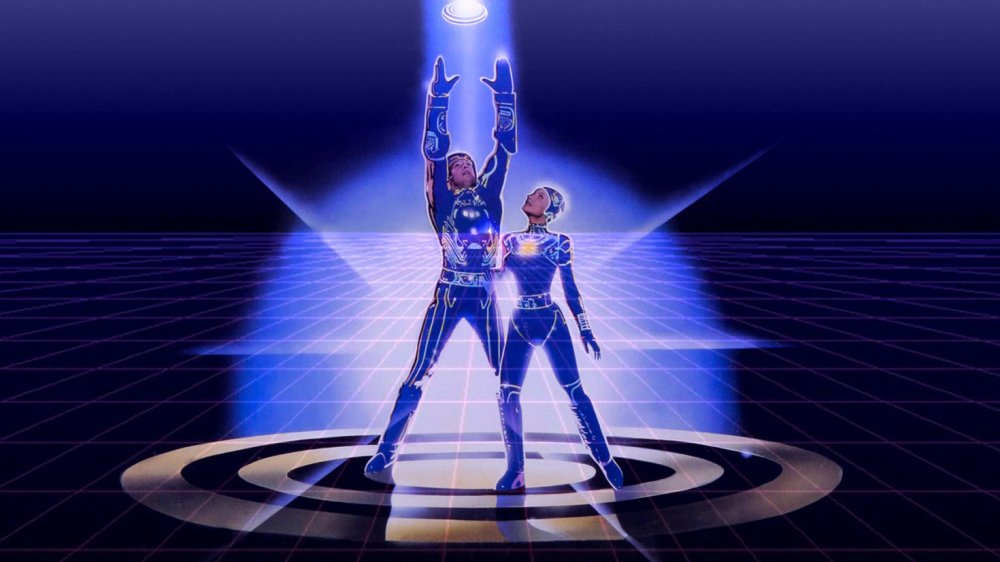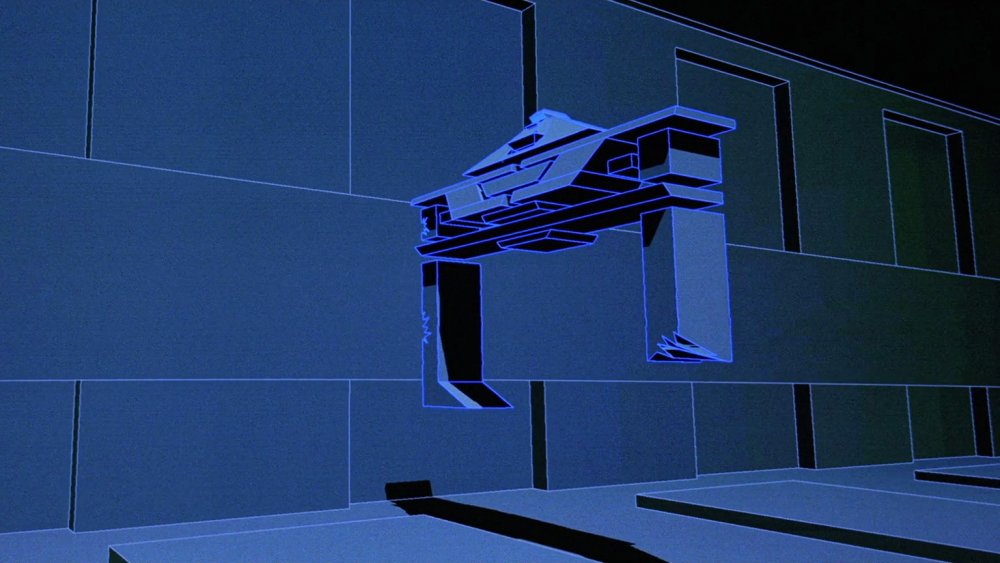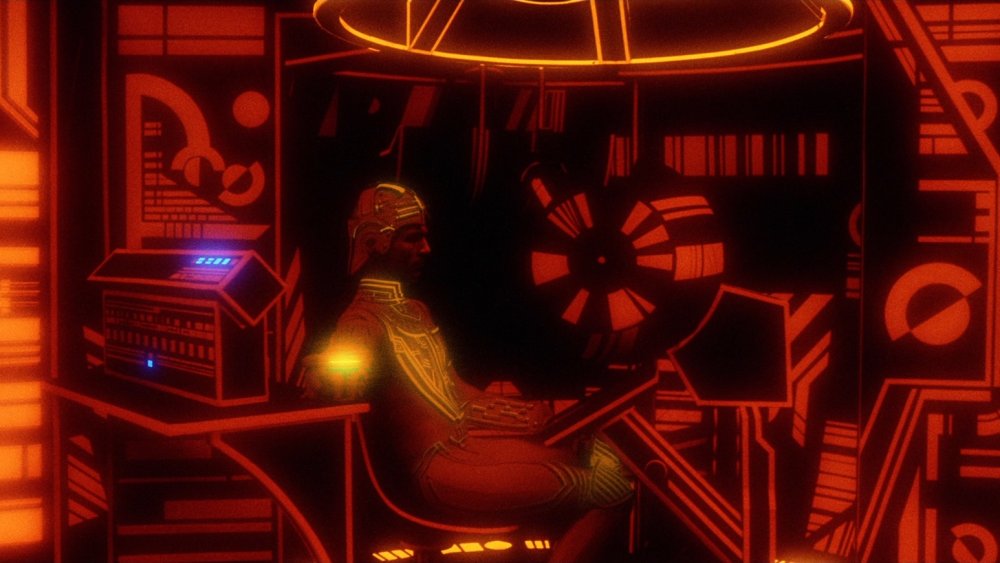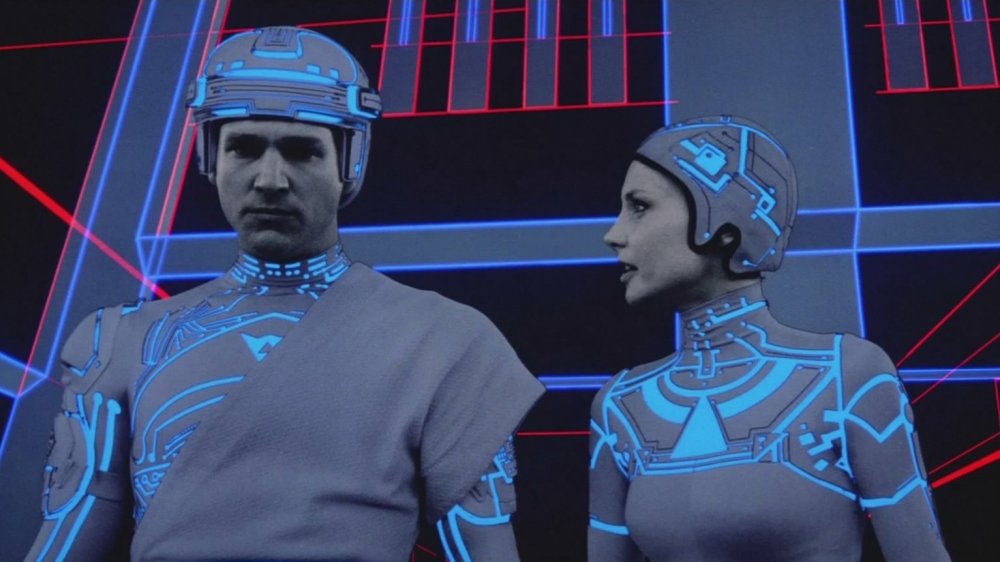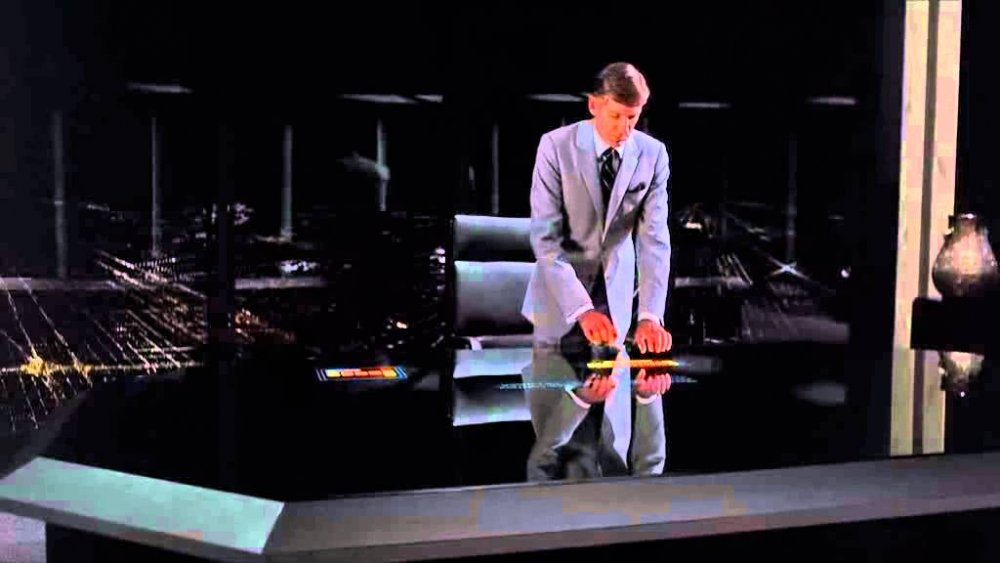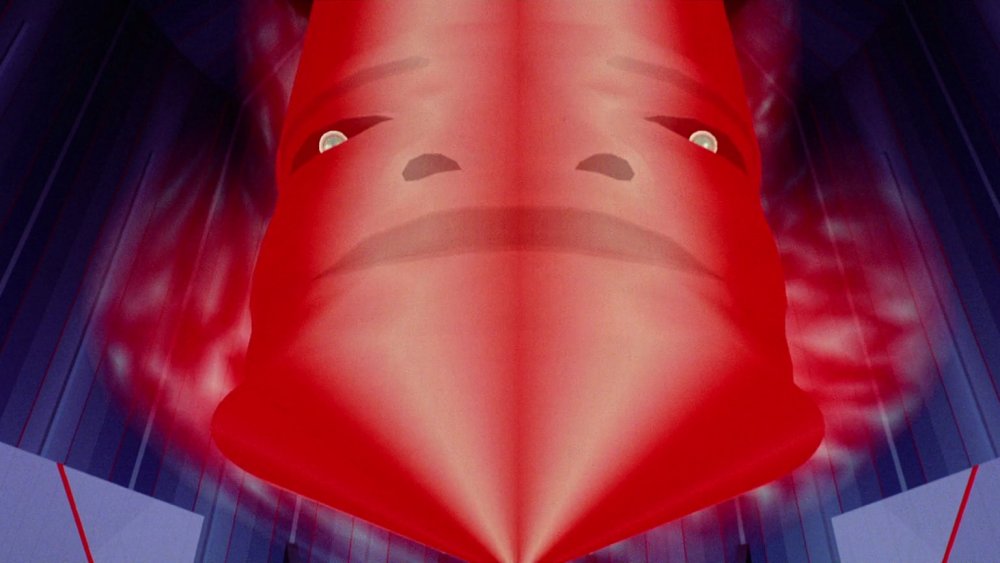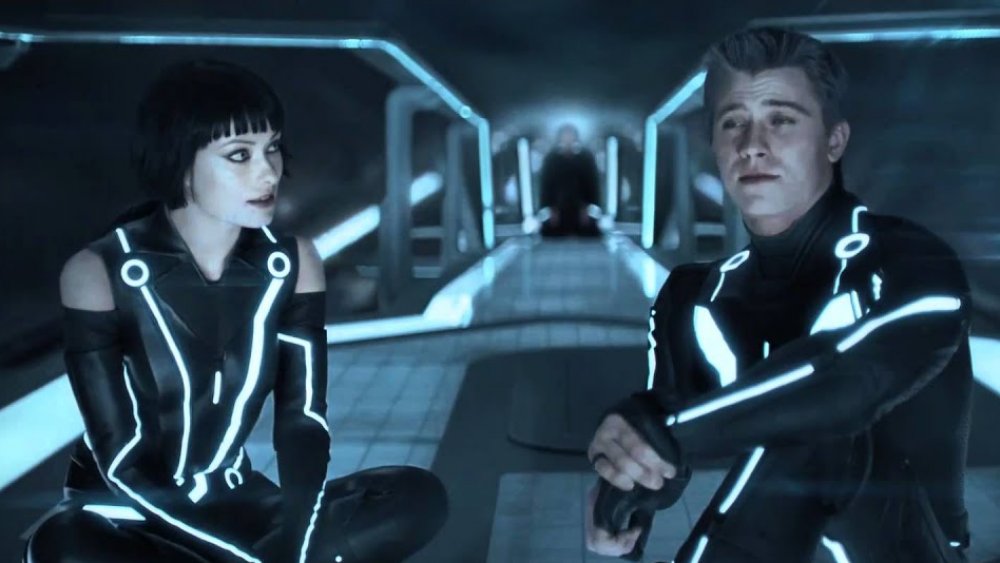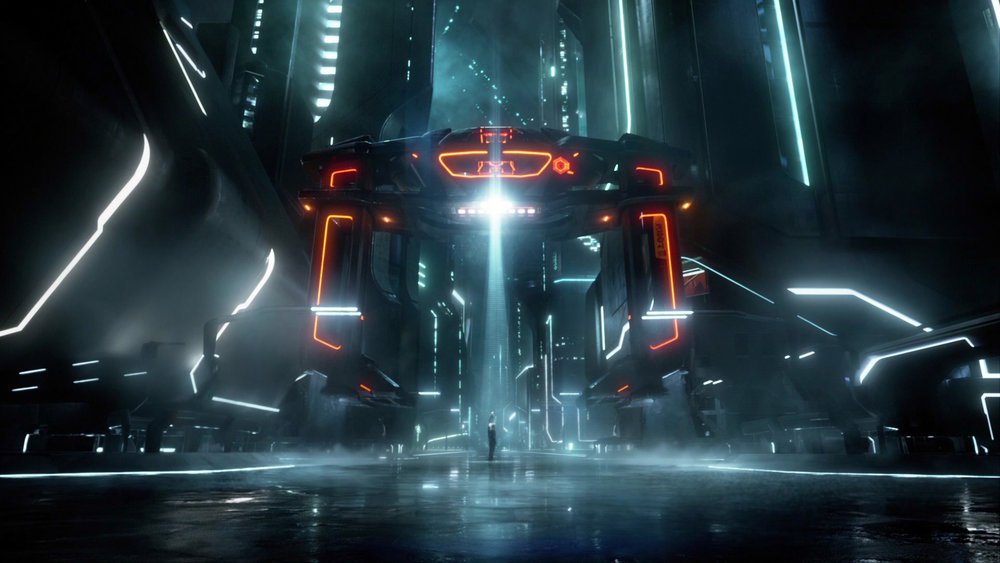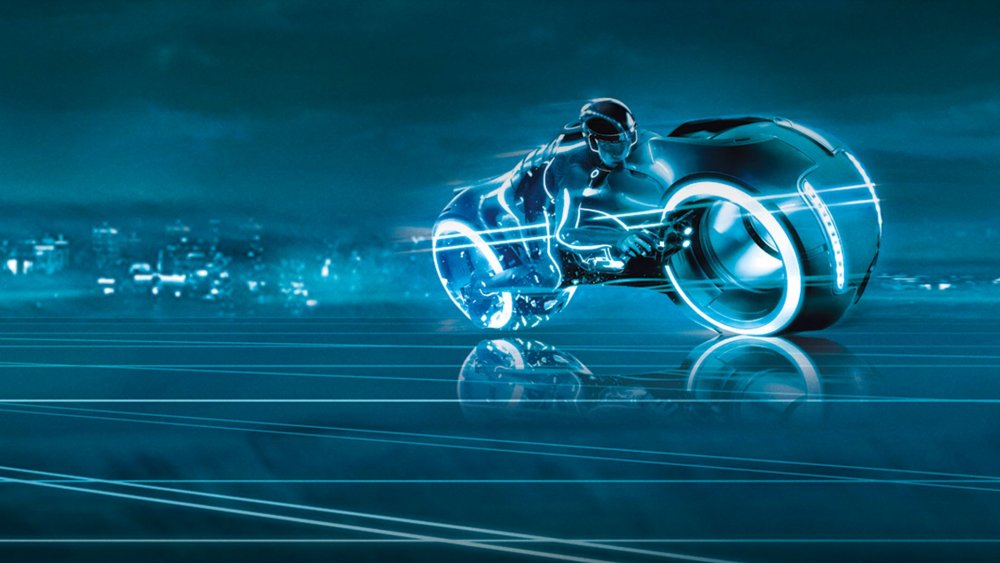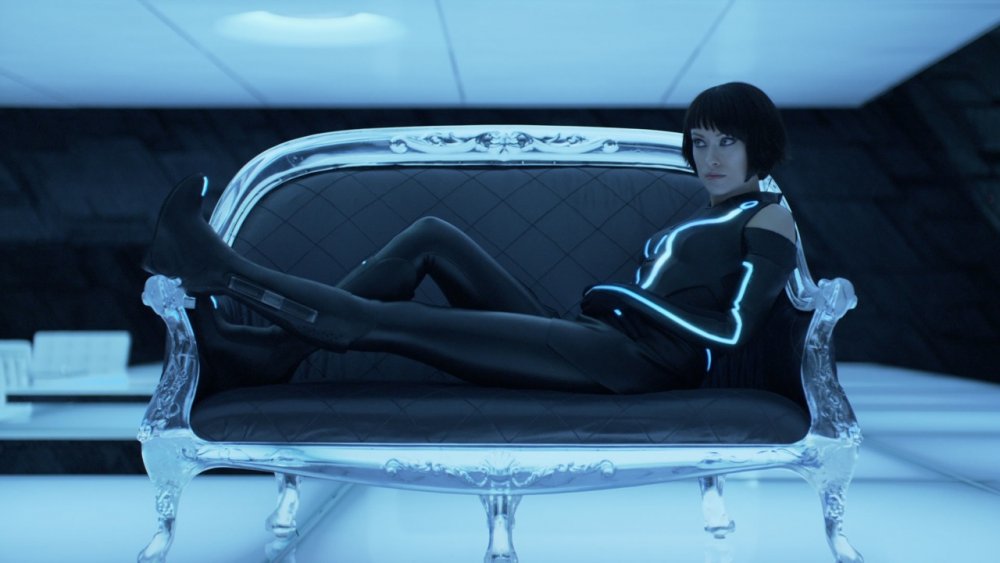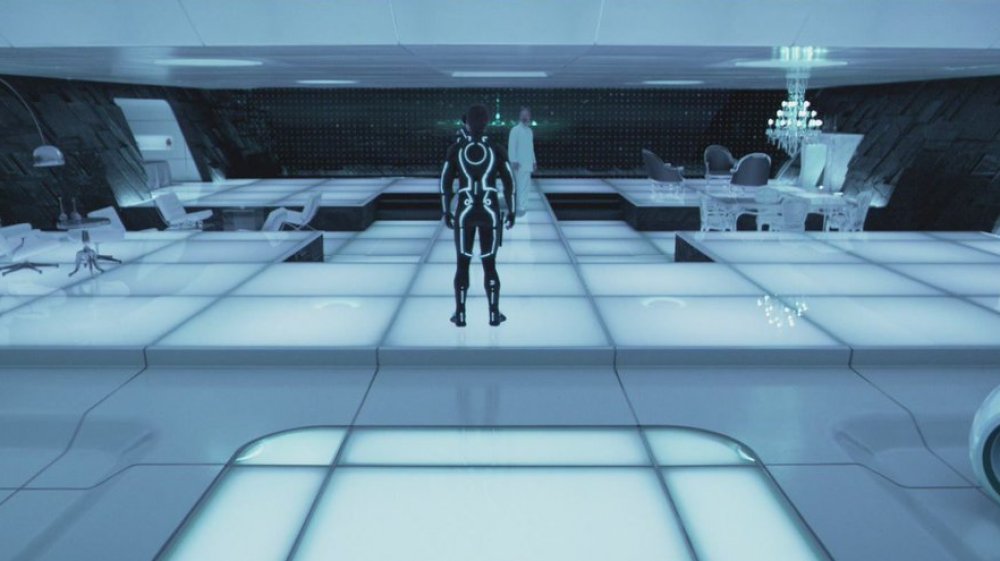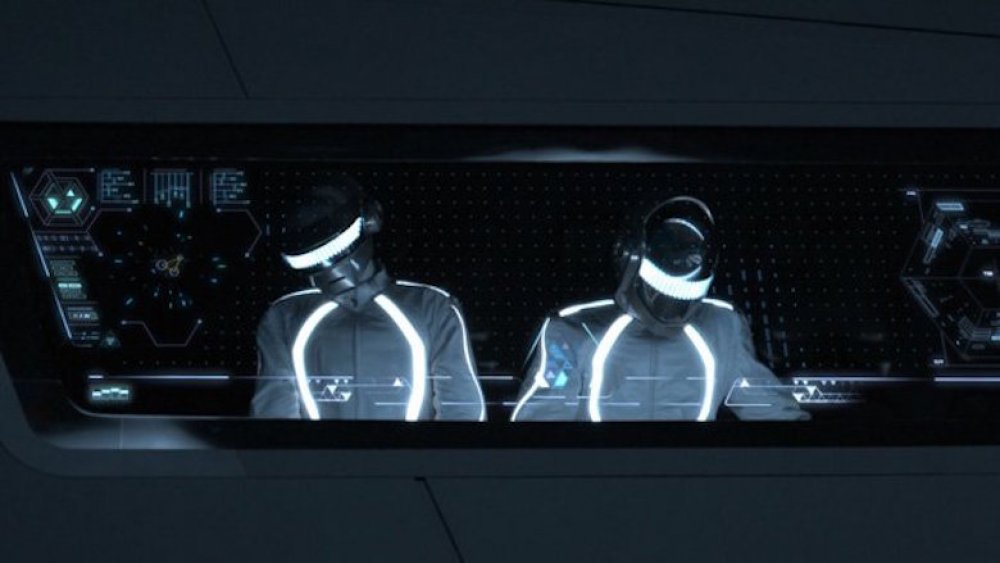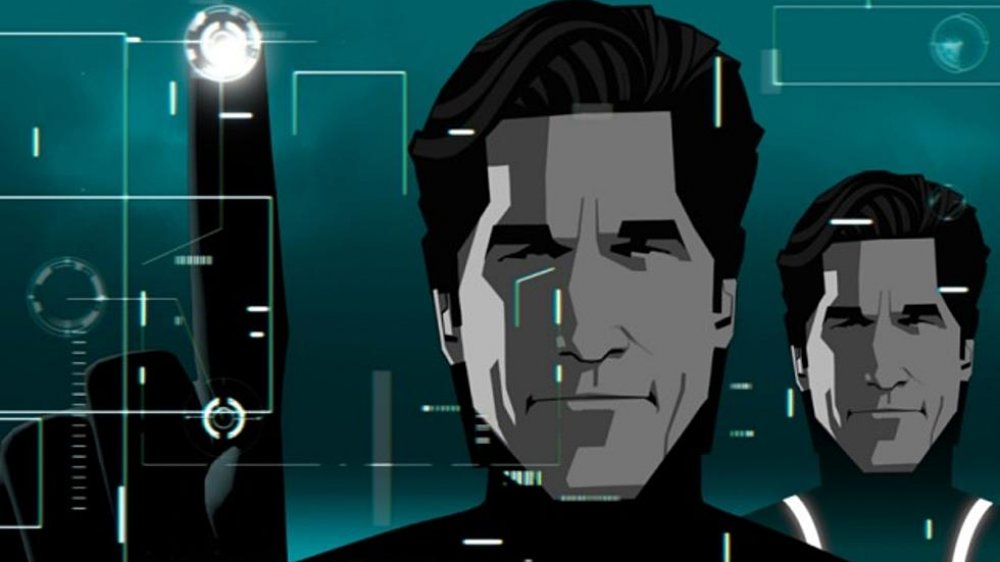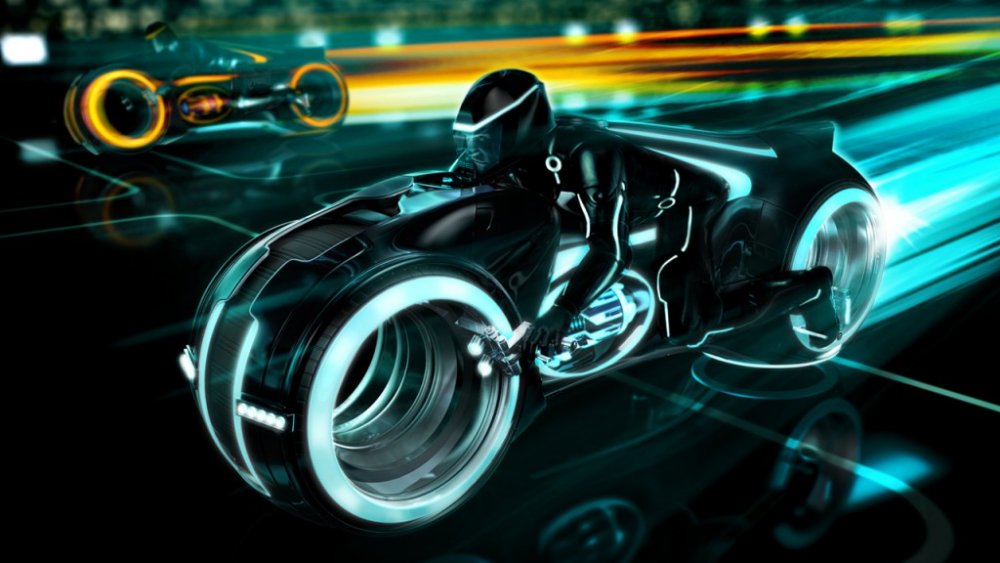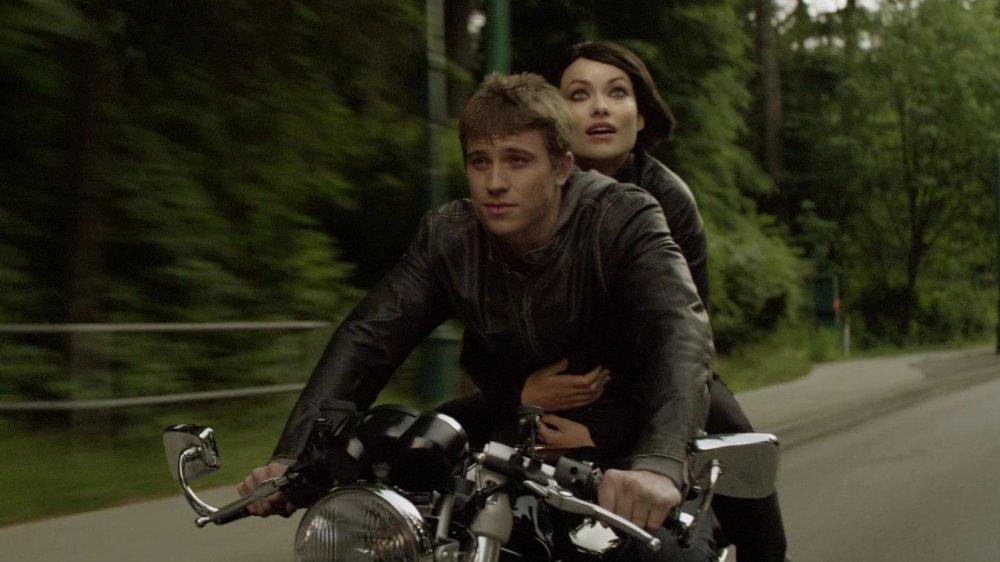The Untold Truth Of Tron
Greetings, Programs, and welcome to the digital frontier. In 1982, first-time director Stephen Lisberger's Tron introduced filmgoers to the Grid — and decades later, Tron has changed the face of film forever in spite of its initial weak box office showing among rave reviews. Tron follows programmer Kevin Flynn (Jeff Bridges) as his physical form is digitized and he finds himself trapped inside a computer program on account of corporate espionage. But you can't really blame Tron for low audience numbers that summer, with its obscure computer-based story going up against Steven Spielberg's era-defining smash E.T.
A persistent cult following helped Tron get re-rezzed in 2010 with the long-awaited sequel Tron: Legacy (helmed by another first-time director, Joe Kosinski), which took us back to the Grid alongside Flynn's son Sam (Garret Hedlund) who follows his dad into the machine after Flynn goes missing again. Featuring a heart-pounding score by Daft Punk, Tron: Legacy utilizes VFX advancements just as its predecessor did, creating a dazzling and kinetic new version of life inside a computer program. While Legacy fared well at the box office, its planned sequel continues to exist in a limbo much like the Grid. As fans continue to hold out hope for a threequel, let's dive into the untold truth of Tron.
Tron was one of the first movies to use CGI
"Without Tron there would be no Toy Story," Disney/Pixar animator John Lasseter has said, and he's not exaggerating. The creative minds behind Tron essentially invented the technology used to design the CGI in the film, which laid foundations for computer graphics developed in the decades since.
Speaking to Variety, director Stephen Lisberger said, "It's inconceivable now for people to think how we actually did the CG. There was no movement. Computers could only generate individual frames. There was no way to digitally put them on film so you actually set up a motion picture camera in front of a computer screen and you filmed it frame by frame. Some of the frames took hours to generate." The film wasn't nominated for an Oscar for its FX, so Lisberger muses, "Tron was so unique that there really wasn't anything to compare it to. So, in a way, they solved the problem by just ignoring it."
While Tron wasn't the first movie to use CGI — that distinction goes to 1981's Looker — it was the first to use it extensively and have the story revolve around it. Not to mention, these graphics by visual artists Moebius and Syd Mead were created on a computer that only had only 2MB of memory and a disc with only 330MB of storage to boot. But Tron was in fact first at making an arcade game tie in, an event that is so commonplace now we don't even take notice anymore.
Tron used a lot of animation as well
There is a common misconception that all of Tron was created using CGI, which isn't accurate. Roughly 20 minutes of the film is pure CGI, and as director Lisberger told D23, "There's no question that Tron is, first of all... a hybrid. It's a live-action movie that then is dismantled, and goes through the entire cel process of hand-animation. And then it's reconstructed, colored, and the effects are put in. And it's re-photographed like an animation film."
For example, the lightcycles and other vehicles were actually animated, not computer-generated using 75,000 frames of "special animation cels" called Kodaliths. These Kodalith animations contained every single piece of information about how characters, sets, and motion would eventually look, and were a huge feat to maintain organized.
Which means that essentially Tron was constructed through cycles of rezzing and de-rezzing from camera to cel to CGI to create its unique look, which only adds to the meta nature of the story. Associate producer and Tron artist Harrison Ellenshaw bragged, "We were not trying to reinvent the wheel. We were trying to make a whole different wheel that was not necessarily round... All movies until Tron were set in an established genre. Tron created a new one."
Tron also used practical effects
Tron's special effects work doesn't stop with its computer-generated imagery, animation Kodaliths, and typical camera work — the filmmakers also used a huge number of practical special effects to capture the action with live actors and physical sets. Dillinger's (David Warner) world, including his view of Los Angeles, was inspired by the actual circuit boards in a computer, and colored 3M tape was used on his helicopter to give it that digital look.
The laser battles were filmed at Lawrence Livermore Laboratory in its linear accelerator using fluorescent lights to create strobe effects. Tron was the first film since 1970 to be completely filmed on 65mm cameras, which eventually had to be composited to print on 70mm and 35mm. Tron also used light sources underneath the characters' costumes, which were white with black lines, to help create the glowing effect. The actors were also filmed against a black background, not green or blue like today.
But one of the most surprising practical effects was the code discs that drive the action of Tron. They don't just look like frisbees, they actually were frisbees; the production even had a frisbee expert on set to train the actors.
Tron predicted the computer age we live in now
There are many aspects that make up Tron's core code, and technological espionage is a huge plot point that was well ahead of its time. In Tron, Kevin Flynn creates his Clu program because he correctly believes that corporate raider Dillinger is stealing from him. Today, it's a regular occurrence — not people being sucked into their own computer programs, but corporations end up outright owning the intellectual property that programmers create. Assorted high-tech skullduggery is commonplace, and corporate tech espionage is daily fact now.
Also, today the phrase "information highway" is such a common part of the vernacular we don't stop to think where it started. One of those places was Tron, where visual metaphors like lightcycles of information and binary bits travelled over a complicated collection of roads as they transmitted their code where it needed to go. In fact, one of the things that made Hollywood balk at the very premise of Tron was an abject fear of technological advances like computers and how they might potentially change the way people live. Today, Hollywood makes much of its money from the concepts explored by Tron in 1982.
And Tron came full circle when the imaginary technology that rezzed Flynn into the computer became real by 2010, when Tron: Legacy was in production and Jeff Bridges' real-life body was scanned and de-aged in order to recreate his younger Clu self from the original.
Tron and Tron: Legacy were inspired by the Holocaust
After helping develop the Master Control Program (MCP) for a set of video games he'd developed, Kevin Flynn is shocked to discover that the program seems not only to have gone rogue, but developed its own intelligence to boot. In Tron the MCP is on the prowl for Flynn and his rezzed allies, but it eventually gathers enough power that it begins blackmailing Dillinger in its pursuit of domination. By Tron: Legacy, the MCP and Flynn's original avatar Clu are not only interested in the destruction of the world outside the machine, but they are also wiping out entire communities inside that they feel are imperfect and impure.
Tron director Stephen Lisberger agrees that his film is absolutely a metaphor for religious persecution along with all of its deliberate Jungian references and imagery, telling Greg Lindsay during a Roger Ebert Film Festival interview, "Yes, yes, yes. It's all that too. My father was a German Jew. And my mother's side of the family put him in a concentration camp. It's like the Civil War. Half my family put the other half in concentration camps. And then they had the power to get them out."
Years later as Tron: Legacy picks up the mantle of the original, this theme only deepens. Liel Liebovitz of Tablet Magazine observes that the link between Clu's desire for a perfect world without glitches or humanity echoes the Holocaust that Lisberger's family barely survived.
The science behind Tron: Legacy is very real
Tron: Legacy opens in a world where Kevin Flynn has gone missing once again. After his son Sam visits the old arcade where Kevin first got digitized and kidnapped by the MCP, the same happens to Sam — but he finds himself in a very different version of the Grid than the one his dad first encountered. Technology has moved on along with the sequel in some key ways.
In Tron: Legacy, original Tron programmer Alan Bradley (Bruce Boxleitner) talks about "genetic algorithms" and "quantum teleportation," both of which are actually real principles, at least in the theoretical field of physics. According to Discover Magazine, these "genetic algorithms" are reflected in Legacy's ISOS characters, programs that created themselves within the Grid. These kinds of programs can in fact emerge spontaneously in a computer program, hence glitches in real life. And to achieve "quantum teleportation," science consultant Sean Carroll suggested Legacy include "canisters of raw materials" like oxygen and carbon which would theoretically make it possible to digitize a human being and then reincorporate their body once again. Or turn a program into flesh, as is the case with Quorra (Olivia Wilde).
Scientific American goes even further into the science of Tron and Tron: Legacy, consulting with a host of physicists and other experts in order to hash out the realities of the science behind these cyberpunk films. They do believe one day soon people will actually be able to get in and walk around inside a version of the Grid.
How CGI and other effects for Tron: Legacy were created
Amazingly, Tron: Legacy director Joe Kosinski actually used the technology Lisberger and company invented for Tron in order to scan, digitize, and create Jeff Bridges' younger self as Clu in Tron: Legacy. Cliff Plumer of Digital Domain, the company that designed the visual FX for the film, described the process to Forbes, saying, "There's a body double, someone performing the body of Clu. You shoot that first. Then you have Jeff [Bridges] do the performance and you're capturing his facial performance. The third component is a computer-generated head of Clu. There really is no margin for error. If the head is not perfectly aligned with the body, it's not going to look right." While this wasn't entirely successful, and young CGI Bridges' stilted appearance is one of the major flaws of Legacy, this was the first time an actor had played his younger self through digital manipulation, making Tron: Legacy as groundbreaking as its predecessor.
But unlike Tron, the Legacy production team utilized technological advances of the day rather than creating their own. Kosinski used the same 3D cameras that James Cameron invented for Avatar, as well as the de-aging techniques used to turn Brad Pitt from old to young over the course of The Curious Case of Benjamin Button.
How they designed the Tron: Legacy vehicles
There is an actual world of iconic imagery in Tron: Legacy that leads back to the original film, and one of those callbacks is the lightcycle vehicles that programs in the computer use to get around the Grid as well as in the fight scenes where the MCP pits programs against programs to the death. But since Legacy has expanded on the original world of Tron, there are a number of new flashy rides in the mix that help Sam Flynn get around in the search for his father. Speaking to Car and Driver, Tron: Legacy lead vehicle designer Daniel Simon went into detail about how the automobiles came together onscreen.
Updating the lightcycle came with its own set of challenges. The world inside the computer is "black on black," so Simon used "read lines" on the motorcycles that they then translated into the glowing stripes that also defined the original cycles. Simon also noted that thanks to the many technological developments in the decades since Tron, he was able to show much more actual vehicle detail like wheels and axles, also adding elements of weather like rain and fog that the original film wasn't able to include.
How Quorra came to be in Tron: Legacy
Tron wasn't just ahead of its time in its tech design — it also blazed a trail for female representation in the character of Lora Baines (Cindy Morgan) who was as strong a programmer as her boyfriend Alan and ex Kevin. In the machine, her digitized equivalent Yori (also played by Morgan) served as a key player in helping Kevin get his info disc and exit the machine. While Tron director Lisberger really wanted to have Yori de-digitize into flesh and join Kevin outside the machine, there wasn't room in the story.
Fast forward to 2010, and Tron: Legacy followed Lisberger's lead to make that vision come true. Enter Quorra (Olivia Wilde), a program that spontaneously emerged in the Grid and a target of Clu's campaign of destruction. Thanks to her allyship with Kevin Flynn, she's obsessed with the real world; by the end of Legacy, when Sam Flynn returns home, he takes Quorra with him — fulfilling not just her dream, but also Stephen Lisberger's.
Tron: Legacy inspired architectural design
After the release of Tron: Legacy, Disney partnered with DuPont Corian and designers as well as architects around the world to create an actual house inspired by the cyberpunk designs of the movie, which was featured during Milan Design Week in 2011. Featuring sleek lines and illuminated edging to match the film, the house truly looks as if you've walked into the Grid and at any moment Kevin Flynn and Quorra will emerge from one of the doorways.
Cool tones, high-backed chairs, and artificial plant life give a minimalist feel while reflecting an imaginary future come to life from the Grid. DuPont Corian as a brand is very on the nose for Tron, being "an advanced surfacing solution that can be shaped into virtually any conceivable design," but it's especially used for high-tech designs, both inside and outside. Where Tron inspired computer technology, Tron: Legacy went even further to inspire actual home and living spaces in the real world that reflect the imagery of the Grid.
How Daft Punk created that epic score/soundtrack for Tron: Legacy
Tron director Stephen Lisberger told D23, "Tron has an analog soul, but it's a movie about CG." This underlying principle and ultimate philosophy about Tron couldn't be better encapsulated than it is with Tron: Legacy's epic score, brought to life by Daft Punk's musical techno-wizardry. Blending electronic music with live orchestral arrangements, in particular strings and percussion, Daft Punk's aural wallpaper for Legacy takes the film to an entirely new level. For two years the French duo worked to create what would eventually become a two-disc album, one featuring the actual score of the movie, and the second a soundtrack of dance remixes featuring a number of other musicians like Crystal Method, Avicii, and Moby.
Talking to the Hollywood Reporter about how they conceived of their project, Daft Punk's Thomas Bangalter said, "Jeff Bridges' character almost looks like the Ten Commandments. We liked this idea of taking classic Hollywood scores and try to clash it against electronics and 1970s science fiction soundtracks with a much darker feel, like John Carpenter." They also talked about how the film's duality spoke to them on many levels, in particular reflecting their original albums and masked public personas, which further fueled the hybrid nature of their Tron: Legacy score.
And because Tron is a loop between real life and the Grid, Daft Punk's own personal style made it easy to give them a cameo in the film without them having to compromise their look even a little bit.
There was a Tron animated series after Legacy
In 2012, Disney released the short-lived animated series Tron: Uprising, which takes place between Tron and Tron: Legacy. The story follows a program in the Grid named Beck (Elijah Wood), who teams up with Tron (voiced by Bruce Boxleitner) in order to confront the megalomaniacal Clu as he continues his pursuit of computer and world dominance. While Tron was thought dead at the hands of Clu (Fred Tatasciore), he survived — and during the course of Uprising, he essentially passes his mantle to Beck, who eventually becomes known as Tron. Uprising also features Tron fan Paul Reubens (a.k.a. Pee-wee Herman) as villain Pavel.
As with Tron before it, director Charlie Bean wanted to create a visual look with computer graphics and animation that hadn't been done on television before, which he accomplished with the help of graphic novel artist Alberto Mielgo and Rob Valley, the man responsible for the Gorillaz' digital presence. "We approach it from a 2D aesthetic," Bean told CBR.com. "That's why it has the look that it does." Unfortunately, the show only lasted for one 19-episode season and was canceled in 2013 due to low viewership.
There's a Tron roller coaster in the works
If you ever wanted to actually ride a lightcycle through the world of the Grid, your dreams are coming true: A Tron roller coaster ride is in the works at Magic Kingdom Park at Disney World Orlando. Aptly positioned in Tomorrowland, the ride is based off of Disney's Tron Lightcycle Power Run at their park in Shanghai, except even larger and more elaborate. Set to open in 2021 during Walt Disney World's 50th anniversary, the Tron Lightcycle Run will allow riders to board their very own solo lightcycle as they power through the digital frontier. The vehicles look exactly like the ones Sam and Quorra use to careen through the Grid, right down to the fluorescent striping and prone seating position.
Aerial photography of the ride shows what will certainly be an immense and almost immersive experience — the roller coaster will feature a canopy but will not be fully enclosed to give riders the feeling they're actually inside the computer as in the movies.
Tron 3 still isn't out of the question
Since 2011, rumors have swirled like data discs through the void about a third Tron film. The on-again-off-again project was supposedly scrapped in 2015, but speaking with Collider in 2017, Tron: Legacy director Joe Kosinski finally had a chance to lay everything he knows about Tron: Ascension on the table. "I guess I can say that Tron 3 is in cryogenic freeze," he mused. "So, it's there. It's not dead. It's alive, but it's sitting there, waiting for the right time to move forward." A huge reason is Disney's purchases of Lucasfilm, Marvel, and Fox, which means the studio has plenty of franchises that will rake in big bucks and a "smaller" project like a third Tron doesn't necessarily have the financial incentive to get a green light.
But Kosinski was able to offer details about what Tron: Ascension might be should it ever get off the Grid and onto screens. "What I'm excited about is the concept, which is an invasion movie from inside the machine coming out as opposed to one we've usually seen," he explained. "The idea for Ascension was a movie that was, the first act was in the real world, the second act was in the world of Tron, or multiple worlds of Tron, and the third act was totally in the real world." Kosinski noted that Quorra would play a huge role as the first digital-human hybrid, and programs entering the real world would be following in her footsteps... though likely not for forces of good. Here's hoping Tron 3 eventually reaches fans.
